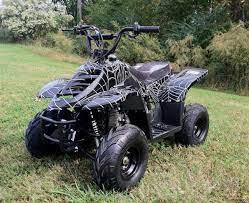
How to Properly Perform Maintenance on a Kids ATV
Share
How to do preventative maintenance on Kids ATVs
When it comes to keeping your small kids ATVs in top-notch condition, regular maintenance is key. Properly maintaining the ATV not only ensures its longevity but also guarantees the safety of your child while riding it. In this comprehensive guide, we will walk you through the essential maintenance tasks that every ATV owner should know.
1. Read the Manual
Before diving into maintenance, it's crucial to thoroughly read the ATV's manual. The manual contains specific instructions from the manufacturer and provides valuable insights into the ATV's components and maintenance requirements. Familiarize yourself with the manual and keep it handy for reference throughout the maintenance process.
2. Clean the ATV
Regularly cleaning your kids ATV not only keeps it looking good but also prevents dirt and debris from causing damage. Start by removing any loose dirt or mud using a soft brush or cloth. Use a mild detergent and water to clean the ATV's body, tires, and other accessible parts. Avoid using harsh chemicals that may harm the ATV's paint or plastic parts. Rinse thoroughly and let it dry completely before moving on to the next maintenance task.
3. Check the Tires
Inspect the tires for any signs of wear or damage. Look for cuts, bulges, or excessive tread wear. Ensure that the tire pressure is within the manufacturer's recommended range. Use a tire pressure gauge to check the pressure and adjust it if necessary. Properly inflated tires provide better traction and stability, ensuring a safer riding experience for your child. Additionally, check the condition of the tire valves and tighten them if needed.
4. Change the Oil
Regular oil changes are vital for maintaining the engine's performance and longevity. Refer to the ATV's manual for the recommended oil type and change intervals. Before starting the oil change process, make sure the engine is cool to avoid burns. Locate the oil drain plug underneath the ATV and place an oil pan beneath it. Remove the plug and let the old oil drain completely. Replace the drain plug and refill the engine with the recommended oil. Be careful not to overfill. Dispose of the old oil properly at a designated recycling center.
5. Inspect the Brakes
The braking system is a critical safety component of any ATV. Regularly check the brake pads for wear and tear. If the brake pads are worn out, replace them immediately to ensure optimal braking performance. Inspect the brake discs or drum for any signs of damage or excessive wear. Also, check the brake fluid level and top up if necessary. If you notice any sponginess or a reduction in braking power, it may indicate a brake system issue that requires professional attention.
6. Lubricate Moving Parts
Proper lubrication of the ATV's moving parts is essential to prevent excessive wear and reduce friction. Apply lubricant to the chain, throttle cable, and any other moving parts as recommended in the manual. Ensure that you use the appropriate lubricant for each specific component. This will help maintain smooth operation and extend the life of these components. Additionally, inspect the suspension components for any signs of damage or wear and address any issues promptly.
7. Inspect the Battery
Check the battery terminals for any signs of corrosion and clean them if needed. Ensure that the battery is securely mounted and properly charged. If the battery is old or not holding a charge, consider replacing it to avoid any unexpected breakdowns. Before handling the battery, make sure the engine is turned off. Familiarize yourself with the battery maintenance guidelines provided in the manual and follow them diligently.
8. Check the Filters
The air filter and fuel filter play a crucial role in the ATV's performance. Regularly clean or replace the air filter to ensure proper air intake. A clogged air filter can result in reduced power and efficiency. Similarly, inspect the fuel filter for any clogs or debris and replace it if necessary. Clean filters contribute to better engine performance and fuel efficiency. Refer to the manual for the recommended maintenance intervals and procedures for the filters.
9. Inspect the Electrical System
The electrical system of your kids ATV should be regularly inspected to ensure proper functioning. Check the wiring harness for any signs of damage or loose connections. Inspect the headlights, taillights, and turn signals to ensure they are working correctly. Test the battery voltage using a multimeter and verify that it is within the recommended range. If you encounter any electrical issues that you are unsure how to fix, consult a professional mechanic.
10. Test the Suspension
Proper suspension is crucial for a smooth and safe ride. Test the suspension by bouncing the ATV up and down. It should feel firm and responsive. If you notice excessive bouncing or sagging, it may indicate worn-out suspension components that need to be inspected and replaced.
11. Check the Spark Plug
Inspect the spark plug for any signs of wear or fouling. A worn-out or dirty spark plug can cause starting issues and poor engine performance. If necessary, clean the spark plug or replace it according to the manufacturer's recommendations. Use a spark plug wrench to remove and install the spark plug properly.
12. Evaluate the Drive Belt
If your kids ATV is equipped with a drive belt, inspect it for any signs of wear, cracks, or glazing. A damaged drive belt can result in poor performance or even complete failure. If you notice any issues with the drive belt, replace it with a new one as per the manufacturer's instructions.
13. Check the Steering System
Inspect the ATV's steering system for any signs of wear or looseness. Check the handlebars for smooth movement and ensure that they are properly aligned. If you notice any issues with the steering system, such as excessive play or difficulty in steering, have it inspected and repaired by a qualified technician.
14. Inspect the Exhaust System
Regularly inspect the exhaust system for any signs of damage, such as cracks or holes. A damaged exhaust system can affect the ATV's performance and may result in excessive noise. Ensure that all connections are secure and tighten any loose bolts or clamps. If you notice any significant issues with the exhaust system, it's best to consult a professional for repair or replacement.
15. Maintain the Fuel System
Proper maintenance of the fuel system is essential for optimal performance. Use clean and fresh fuel, and avoid using ethanol-blended fuels if they are not recommended by the manufacturer. Regularly inspect the fuel lines for any signs of damage or leaks. Clean the carburetor or fuel injectors as per the manufacturer's recommendations. If you encounter any fuel system issues that you are unsure how to fix, seek professional assistance.
Conclusion
By following these comprehensive maintenance tips, you can ensure that your kids ATV stays in excellent condition for years to come. Regular cleaning, tire checks, oil changes, brake inspections, lubrication, battery checks, filter maintenance, electrical system inspections, suspension tests, spark plug evaluations, drive belt evaluations, steering system checks, exhaust system inspections, and fuel system maintenance are all essential for a safe and enjoyable riding experience. Always consult the ATV's manual for specific maintenance instructions and recommended intervals. Prioritize safety and regular maintenance to keep your kids ATV running smoothly and your child's riding experience enjoyable. Happy riding!
